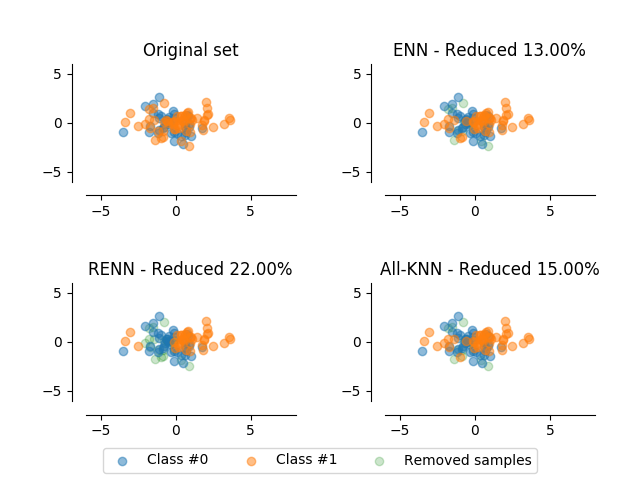ENN, RENN, All-KNN¶
An illustration of the ENN, RENN, and All-KNN method.

Out:
ENN
Reduced 13.00%
RENN
Reduced 22.00%
AllKNN
Reduced 15.00%
# Authors: Dayvid Oliveira
# Christos Aridas
# Guillaume Lemaitre <g.lemaitre58@gmail.com>
# License: MIT
import matplotlib.pyplot as plt
import numpy as np
from sklearn.datasets import make_classification
from sklearn.decomposition import PCA
from imblearn.under_sampling import (AllKNN, EditedNearestNeighbours,
RepeatedEditedNearestNeighbours)
print(__doc__)
def plot_resampling(ax, X, y, title):
c0 = ax.scatter(X[y == 0, 0], X[y == 0, 1], label="Class #0", alpha=0.5)
c1 = ax.scatter(X[y == 1, 0], X[y == 1, 1], label="Class #1", alpha=0.5)
ax.set_title(title)
ax.spines['top'].set_visible(False)
ax.spines['right'].set_visible(False)
ax.get_xaxis().tick_bottom()
ax.get_yaxis().tick_left()
ax.spines['left'].set_position(('outward', 10))
ax.spines['bottom'].set_position(('outward', 10))
ax.set_xlim([-6, 8])
ax.set_ylim([-6, 6])
return c0, c1
# Generate the dataset
X, y = make_classification(n_classes=2, class_sep=0.4, weights=[0.4, 0.6],
n_informative=3, n_redundant=1, flip_y=0,
n_features=5, n_clusters_per_class=1,
n_samples=100, random_state=10)
# Instanciate a PCA object for the sake of easy visualisation
pca = PCA(n_components=2)
# Fit and transform x to visualise inside a 2D feature space
X_vis = pca.fit_transform(X)
# Three subplots, unpack the axes array immediately
f, ((ax1, ax2), (ax3, ax4)) = plt.subplots(2, 2)
c0, c1 = plot_resampling(ax1, X_vis, y, 'Original set')
# Apply the ENN
print('ENN')
enn = EditedNearestNeighbours(return_indices=True)
X_resampled, y_resampled, idx_resampled = enn.fit_sample(X, y)
X_res_vis = pca.transform(X_resampled)
idx_samples_removed = np.setdiff1d(np.arange(X_vis.shape[0]), idx_resampled)
reduction_str = ('Reduced {:.2f}%'.format(100 * (1 - float(len(X_resampled)) /
len(X))))
print(reduction_str)
c3 = ax2.scatter(X_vis[idx_samples_removed, 0],
X_vis[idx_samples_removed, 1],
alpha=.2, label='Removed samples', c='g')
plot_resampling(ax2, X_res_vis, y_resampled, 'ENN - ' + reduction_str)
# Apply the RENN
print('RENN')
renn = RepeatedEditedNearestNeighbours(return_indices=True)
X_resampled, y_resampled, idx_resampled = renn.fit_sample(X, y)
X_res_vis = pca.transform(X_resampled)
idx_samples_removed = np.setdiff1d(np.arange(X_vis.shape[0]), idx_resampled)
reduction_str = ('Reduced {:.2f}%'.format(100 * (1 - float(len(X_resampled)) /
len(X))))
print(reduction_str)
ax3.scatter(X_vis[idx_samples_removed, 0],
X_vis[idx_samples_removed, 1],
alpha=.2, label='Removed samples', c='g')
plot_resampling(ax3, X_res_vis, y_resampled, 'RENN - ' + reduction_str)
# Apply the AllKNN
print('AllKNN')
allknn = AllKNN(return_indices=True)
X_resampled, y_resampled, idx_resampled = allknn.fit_sample(X, y)
X_res_vis = pca.transform(X_resampled)
idx_samples_removed = np.setdiff1d(np.arange(X_vis.shape[0]), idx_resampled)
reduction_str = ('Reduced {:.2f}%'.format(100 * (1 - float(len(X_resampled)) /
len(X))))
print(reduction_str)
ax4.scatter(X_vis[idx_samples_removed, 0],
X_vis[idx_samples_removed, 1],
alpha=.2, label='Removed samples', c='g')
plot_resampling(ax4, X_res_vis, y_resampled, 'All-KNN - ' + reduction_str)
plt.figlegend((c0, c1, c3), ('Class #0', 'Class #1', 'Removed samples'),
loc='lower center', ncol=3, labelspacing=0.)
plt.tight_layout(pad=3)
plt.show()
Total running time of the script: ( 0 minutes 1.585 seconds)